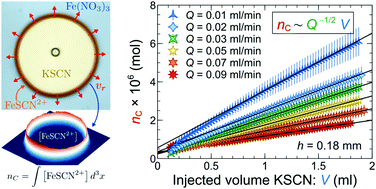Effects of radial injection and solution thickness on the dynamics of confined A + B → C chemical fronts
Abstract
The spatio-temporal dynamics of an A + B → C front subjected to radial advection is investigated experimentally in a thin solution layer confined between two horizontal plates by radially injecting a solution of potassium thiocyanate (A) into a solution of iron(III) nitrate (B). The total amount and spatial distribution of the product FeSCN2+ (C) are measured for various flow rates Q and solution thicknesses h. The long-time evolution of the total amount of product, nC, is compared to a scaling obtained theoretically from a one-dimensional reaction–diffusion–advection model with passive advection along the radial coordinate r. We show that, in the experiments, nC is significantly affected when varying either Q or h but scales as nC ∼ Q−1/2V where V is the volume of injected reactant A provided the solution thickness h between the two confining plates is sufficiently small, in agreement with the theoretical prediction. Our experimental results also evidence that the temporal evolution of the width of the product zone, WC, follows a power law, the exponent of which varies with both Q and h, in disagreement with the one-dimensional model that predicts WC ∼ t1/2. We show that this experimental observation can be rationalized by taking into account the non-uniform profile of the velocity field of the injected reactant within the cell gap.



 Please wait while we load your content...
Please wait while we load your content...